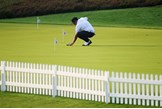How much better at putting is a scratch golfer than a 10-handicapper?
Published: Last updated:
Rob McGarr has been stuck on a 10 handicap for too long. He wants to get to scratch.
Catch up on his journey so far:
Part One: How hard can it be to go from 10 to scratch?
Part Two: I’m trying to get from 10 to scratch, and now I’m off 11…
Part Three: My first cut and two costly missed tiddlers
Part Four: How many hours per week does it take to get to scratch?
_________
Part Five: A putting practice schedule to get from 10 to scratch
In my last blog, I talked about the amount of practice it takes to get from 10 to scratch. I realised, with the help of my coach Mark Jackson and leading golf psychologist Dr Bob Rotella, that I simply hadn’t been doing enough.
Getting practice right is imperative if I am to have any chance of succeeding in my aim to get to scratch.
First, I need to be practising enough.
So I’ve started practising for four hours a day. I’ve found that getting up early and being at the course by 7am enables me to practise for that amount of time without feeling like the entire day is gone. It also means that the course and practice areas aren’t overly busy, which means I can get more done with fewer distractions (I mean retirees wandering across the putting green, not hordes of fans hassling me for autographs).
But, as well as quantity, I need quality. I need to be practising effectively. I need to be doing the right things.
Over the next couple of blog posts, I’ll give you the full detail of all of the practice I’m doing at the moment. If you like the look of it, why not give it a try for yourself? Or if you think it could be improved, please feel free to let me know on Twitter – I’m @robmcgarr.
Please bear in mind that I’m certainly not an expert. And, clearly, I’m not a golf pro. If I was, this whole journey to scratch would be a short and completely nonsensical one. I’ve merely devised a few drills that I think will help me in key areas, based on things from Rotella’s book ‘The Golf of Your Dreams‘ and a variety of instructional articles and videos I’ve taken in over the years.
First, let’s start with putting.
45 minutes a day to putt like a scratch golfer
I always considered myself to be a pretty decent putter, but my recent stats tell a completely different story. I’m three-putting, missing too many putts from close range, and generally costing myself several shots per round on the element of the game that, let’s face it, should be the simplest.
I have devised three drills to transform me from a three-putting pillock into a jolly green giant.
1. 3′ compass drill (15 minutes)
There are nine holes on the putting green at Burghley Park. I start at one hole and do the ‘compass drill’, hitting a putt from ‘north’, ‘south’, ‘east’ and ‘west’ of that hole, each from three feet. I repeat this on each of the nine holes, totalling 36 putts. (Nine times four is 36, maths fans.) This gets me used to holing those putts you shouldn’t miss from above and below the hole, and with left and right break.
The idea of this drill is to feel that I am going to hole every putt from three feet. On the course, this takes the pressure off my first putt, as anything that finishes within three feet of the hole will not lead to a three-putt. It also means that I am more likely to convert a good chip into a par save.
Daniel Summerhays made 941 out of 941 putts from 3 feet and in last season. He was one of seven players to be perfect from this range, includng world number one Jason Day.
At present, I’m scoring around 29/36, meaning I’d likely miss at least one or two short putts in the average round. I cannot afford to drop shots from such short distances if I want to score well, so this drill is key.
My target is to hole 36/36 of these putts.
2. 6′ compass drill (15 minutes)
I repeat exactly the same drill, but this time from six feet. Clearly, I cannot expect to hole everything from this range, but increasing my percentage from this distance will help me convert birdie opportunities after good approaches and enable me to save par even if my chip isn’t quite as close as I would have liked or my first putt is poor.
I”m currently scoring 13/36 at this drill. The best players on tour average around 85% from six feet, while tour average is about 70%. At my current 36% success rate, I’d be last by a mile. I’d like to be holing at least half of these putts.
3. 3-putt avoidance drill (15 minutes)
I choose two holes on the putting green that are a long way apart. Using one ball only, I have 18 attempts, nine from each direction. Par is a two-putt, and my goal is to be level par or better.
The purpose of this exercise is to improve distance control on the first putt, while implementing the skills from the first two drills in a pressure situation if my first putt isn’t stone-dead.
I make sure I’m not using the same two holes day after day, as I would get used to the break and distance of just that specific line.
My aim for this exercise is to be level par or better. At present, I’m finding myself eight-over, which means I’d be likely to three-putt at least a few times during a round. This is something I really need to eliminate, and doing this drill every day should be a significant help.

Score tracking and forfeits
I make a note of my score on each of the above drills. This is helpful so I can gauge my current level of ability, and track my progress.
I also use forfeits as a means of adding pressure. One of the most important parts of practice is making it reflect real golf. If you’ve ever found yourself doing brilliantly during practice, but struggling on the course – and I know I have – it’s probably because your practice does not replicate the pressure of real golf. Adding a pressure element to your practice is key. Set yourself target scores, and have forfeits in place if you miss the target.
If I don’t hit my target score with any of the above three drills for instance, I have to do 50 left-arm swings, which is another drill I’ll explain shortly, or a set of 10 chin-ups (I mean when I get home – I’m not hanging off trees on the course like Tarzan). This adds a bit of pressure, but even if I do fail, I end up practising more, so it’s a win-win situation.
Next time…
In my next post I’ll share the practice I’m doing on my full swing. It’s something I’ve never done before, but it’s making a huge difference to my accuracy and ball-striking.


